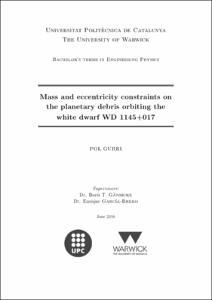Mostra el registre d'ítem simple
Mass and eccentricity constraints on the planetary debris orbiting the white dwarf WD 1145+017
| dc.contributor | García-Berro Montilla, Enrique |
| dc.contributor | Gänsicke, Boris T. |
| dc.contributor.author | Gurri Pérez, Pol |
| dc.contributor.other | Universitat Politècnica de Catalunya. Departament de Física |
| dc.date.accessioned | 2016-07-26T16:16:58Z |
| dc.date.available | 2016-07-26T16:16:58Z |
| dc.date.issued | 2016-06-29 |
| dc.identifier.uri | http://hdl.handle.net/2117/89231 |
| dc.description | Most stars in the Universe will eventually end their lives as white dwarfs: Earth-sized burned-out stellar cores, prevented from further collapsing by the pressure of degenerate electrons. Interest in the study of white dwarfs ranges from testing our knowledge of stellar structure and evolution to the progenitors of the extremely luminous type Ia supernovae that led to the discovery of dark energy. However, over the past decade, white dwarfs also opened up a new area of research on exo-planets. Since the discovery of the first extra-solar planet in 1995, we now know that ha |
| dc.description.abstract | Being the first of its kind, the white dwarf WD 1145+017 exhibits a complex system of disintegrating debris which offers a unique opportunity to study its disruption process in real time. Even with plenty of transit observations there are no clear constraints on the masses or eccentricities of such debris. Using N-body simulations we show that masses greater than a tenth of the mass of Ceres or orbits that are not nearly circular dramatically increase the chances of the system becoming unstable within two years, which would contrast with the observational data over this timespan. We also provide a direct comparison between transit phase shifts detected in the observations and by our numerical simulations. |
| dc.description.abstract | Siendo la primera de su tipo, la enana blanca WD 1145+017 muestra un complejo sistema de planetas orbitándola. Este trabajo usa simulaciones numéricas para determinar restricciones en masa y excentricidad para los cuerpos orbitando WD 1145+017. |
| dc.description.abstract | Sent la primera de la seva classe, la nana blanca WD 1145+017 llueix un complex sistema de planetes orbitant-la. Aquest treball utilitza simulacions numèriques per determinar restriccions en massa i excentricitat pels objectes orbitant WD 1145+017. |
| dc.language.iso | eng |
| dc.publisher | Universitat Politècnica de Catalunya |
| dc.relation.uri | http://infoteleco.upc.edu/incoming/pfc/117820/posterTFG_JVmGNA.pdf |
| dc.rights | S'autoritza la difusió de l'obra mitjançant la llicència Creative Commons o similar 'Reconeixement-NoComercial- SenseObraDerivada' |
| dc.rights.uri | http://creativecommons.org/licenses/by-nc-nd/3.0/es/ |
| dc.subject | Àrees temàtiques de la UPC::Física::Astronomia i astrofísica |
| dc.subject.lcsh | Astrophysics |
| dc.subject.lcsh | Programming (Mathematics) |
| dc.subject.lcsh | Computer simulation |
| dc.subject.other | simulation |
| dc.subject.other | white dwarfs |
| dc.subject.other | simulaciones |
| dc.subject.other | enana blanca |
| dc.title | Mass and eccentricity constraints on the planetary debris orbiting the white dwarf WD 1145+017 |
| dc.title.alternative | Restricciones de masa y excentricidad para el sistema WD 1145+017 |
| dc.title.alternative | Restriccions en massa i excentricitat per WD 1145+017 |
| dc.type | Bachelor thesis |
| dc.subject.lemac | Astrofísica |
| dc.subject.lemac | Programació (Matemàtica) |
| dc.subject.lemac | Simulació per ordinador |
| dc.identifier.slug | ETSETB-230.117820 |
| dc.rights.access | Open Access |
| dc.date.updated | 2016-07-07T05:51:43Z |
| dc.audience.educationlevel | Grau |
| dc.audience.mediator | Escola Tècnica Superior d'Enginyeria de Telecomunicació de Barcelona |
| dc.audience.degree | GRAU EN ENGINYERIA FÍSICA (Pla 2011) |
| dc.contributor.covenantee | University of Warwick |


